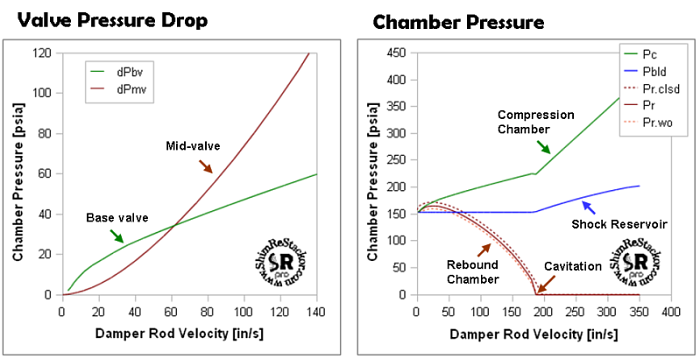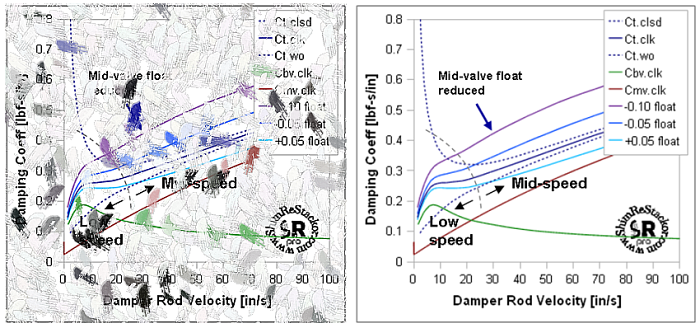

Sample Applications

ReStackor Accuracy
ReStackor pro Fluid Dynamics
Cavitation limits of a shock absorber are defined by small differences in large numbers. Errors in computation of the base valve pressure drop by 10 psi does not produce a large impact in overall damping force. But, if the base valve pressure drop is 10 psi high and the mid-valve is 10 psi low the 20 psi swing in pressure can easily be the difference between a suspension cavitating or not. That sensitivity makes cavitation limits very difficult to compute without specific calibration of the calculations to the specific suspension setup you are tuning. Test rides are required to quantify the system performance.

Cavitation limits depend on small differences in large pressure drops
Suspension Tuning
Interpretation and tuning of suspensions from test ride results is the central focus of ReStackor. This in-situ tuning process gives you the capability to test your suspension on the actual terrain and speed that you ride, relate suspension performance to clicker settings and define the specific suspension modifications needed to achieve specific changes in damping performance.
Under actual ride conditions, it makes little difference whether your suspension cavitates at the suspension velocities of a 4 inch bump or a 5 inch bump. The fact is it cavitates and cavitation produces a range of suspension ills easily identified by the calculations of ReStackor. ReStackor gives you the capability to understand the cause of cavitation, the effect of cavitation on suspension performance and the capability to identify the specific component modifications needed to control cavitation.
The Art of Suspension Tuning
Your success at implementing in-situ suspension tuning depends on your ability to implement the art of suspension tuning. That art requires the ability to relate the idea of suspension feel onto the fuzzy impressionist pallet of suspension operation and emerge onto the sharply focused snapshot of ReStackor plots describing the underlying physics governing operation of your suspension. That process is an art and does not proceed with the arithmetic precision of checkbook balancing.
The art of suspension tuning requires the ability to work beyond the numbers and relate the idea of suspension feel to the fundamental operation characteristics of the suspension system.
Simplification of the complex fluid dynamic processes occurring in a shock and the compendium of unknown unknowns render computation of cavitation limits nothing more than a guide for tuning of a suspension system. That guide however, exposes the underlying physical flow processes occurring within a shock and supplies the component performance details necessary to understand and tune a suspension. Here on the edge of math, physics and the elusive quantification of suspension feel computation of damping performance does not proceed with the numeric precision of check book balancing. It is an interpreted art and operates on no known numerical scale.
Suspension tuning is and remains an art. ReStackor simply supplies the tools needed to implement and interpret that art. If you expect more, seek professional help.

